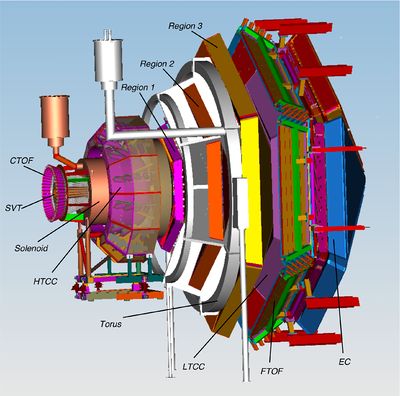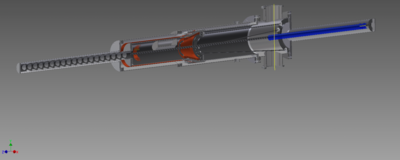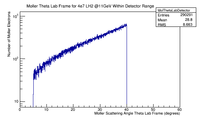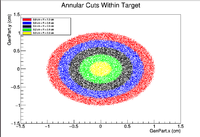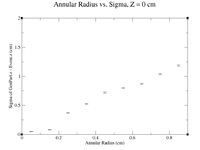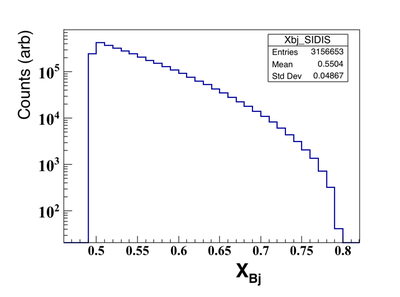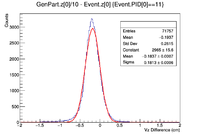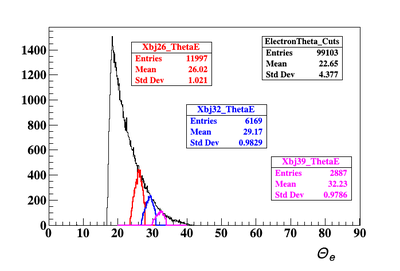Difference between revisions of "2015 NSF Proposal"
| (17 intermediate revisions by 2 users not shown) | |||
| Line 20: | Line 20: | ||
==June 2017== | ==June 2017== | ||
| + | |||
| + | ===Dustin's Stuff=== | ||
| + | |||
| + | =Major Goals:= | ||
| + | |||
| + | Probing Nuclear structure with Parity Violation: Neutron radii and skin measurements | ||
| + | |||
| + | *The Pb Radius Experiment (PREX) | ||
| + | |||
| + | *The Ca Radius Experiemnt (CREX) | ||
| + | |||
| + | Preparing for BSM physics searches using Parity Violation in purely leptonic sector | ||
| + | |||
| + | *The MOLLER experiment | ||
| + | |||
| + | =What was Accomplished:= | ||
| + | |||
| + | Activities | ||
| + | |||
| + | |||
| + | Objectives | ||
| + | |||
| + | |||
| + | Results | ||
| + | |||
| + | |||
| + | Key Outcomes: | ||
| + | |||
| + | *PREX-II and CREX passed their Experiment Readiness Review on May 19, 2017 and can now request scheduling; expectation is that the experiments will run consecutively in Fall 2018 or Winter/Spring 2019. | ||
| + | |||
| + | *The MOLLER experiment achieved DOE's CD-0 status at the end of December 2016. This means the collaboration has achieved mission-need recognition from DOE. | ||
| + | |||
| + | =Opportunities for Training:= | ||
| + | |||
| + | =Dissemination of Results:= | ||
| + | |||
| + | =Plans for next reporting period:= | ||
| + | |||
| + | |||
| + | ==Tony's stuff== | ||
| + | |||
| + | ===2018 report=== | ||
| + | Since constructing the R1 drift chambers for the CLAS12 upgrade, the group has been preparing for upcoming experiments by focusing on simulations to optimize run conditions. A program to optimize CLAS12's ability to detect pions is currently underway. Three components of this effort currently at various stages of completion are to incorporated a dual polarized target geometry into the official CLAS12 simulation, quantify the moller electron background for beam pipe shielding, and improve the vertex reconstruction for a dual polarized target. The geometry and materials for polarized target to be used in an upcoming experiment in JLab's Hall B has been completed and is being incorporated in the Hall's monte-carlo distribution. The background from Moller scattering in Hall B has been simulated and is now guiding the design of beam line shielding elements with the results to be reported in a graduate student thesis this year. A second graduate student has begun work on adapting the tracking software to accommodate reconstructing vertices when using the above dual polarized target. These three efforts will be used to optimized data taking in JLab's Hall B during the Fall of 2020. | ||
| + | |||
| + | ====Accomplshments==== | ||
| + | |||
| + | ====Products - What has the project produced==== | ||
| + | |||
| + | |||
| + | 1.) | ||
| + | <pre> | ||
| + | Conference date: 12–15 September 2017 | ||
| + | Location: Newport News, VA, USA | ||
| + | ISBN: 978-0-7354-1677-2 | ||
| + | Editors: Joseph Grames and Eric Voutier | ||
| + | Volume number: 1970 | ||
| + | Published: May 25, 2018 | ||
| + | |||
| + | Preface: International Workshop on Positron Physics at Jefferson Lab (JPos17) | ||
| + | |||
| + | Citation: AIP Conference Proceedings 1970, 010001 (2018); doi: 10.1063/1.5040193 View online: https://doi.org/10.1063/1.5040193 | ||
| + | |||
| + | View Table of Contents: http://aip.scitation.org/toc/apc/1970/1 | ||
| + | |||
| + | Published by the American Institute of Physics | ||
| + | </pre> | ||
| + | |||
| + | |||
| + | 2.)If any of you are needing to submit NSF project reports (or whatever | ||
| + | the equivalent is for the DOE), you may have seen the new regulations | ||
| + | regarding the Public Access requirement - this essentially | ||
| + | requires that the U.S. public be provided free access to scientific papers | ||
| + | published arising from U.S. Federal taxpayer dollars, eg. NSF or DOE | ||
| + | grants. The NSF has set up a Public Access Repository, | ||
| + | ( https://par.nsf.gov/ ) which is supposed to seamlessly interact with | ||
| + | the DOE/OSTI E-Link system; these are where final published versions | ||
| + | of the papers can be uploaded to, and where the public is then able to | ||
| + | access them. | ||
| + | |||
| + | What about our Nature paper? Isn't it embargoed (i.e. we can't | ||
| + | upload the final version to the arXiv for six months) as part of | ||
| + | Nature's business model? Can/should we upload it to NSF_PAR? | ||
| + | |||
| + | Wouter and I had our annual report for our NSF grant due, so | ||
| + | I looked into this. It turns out that if you upload to NSF-PAR | ||
| + | using the DOI (Digital Object Identifier) for our paper | ||
| + | (our DOI 10.1038/s41586-018-0096-0 ), Nature automatically supplies | ||
| + | the metadata for the paper, which includes an embargo, i.e. the paper's | ||
| + | title and author list are posted, but it states "This content will become | ||
| + | publicly available on May 1, 2019" (see | ||
| + | https://par.nsf.gov/biblio/10062439-precision-measurement-weak-charge-proton ). | ||
| + | |||
| + | I am not sure if you can somehow link this to your own annual report; | ||
| + | I am trying to discover this.... | ||
| + | |||
| + | One small irritation I uncovered: the metadata from Nature doesn't | ||
| + | have the author list in the format required by NSF-PAR. I had to | ||
| + | manually convert it; for your convenience, I have appended the correctly | ||
| + | formatted author list to this email. | ||
| + | |||
| + | cheers, | ||
| + | David | ||
| + | |||
| + | --------------------------------------- | ||
| + | |||
| + | Androic, D.; Armstrong, D. S.; Asaturyan, A.; Averett, T.; Balewski, J.; Bartlett, K.; Beaufait, J.; Beminiwattha, R. S.; Benesch, J.; Benmokhtar, F.; Birchall, J.; Carlini, R. D.; Cornejo, J. C.; Covrig Dusa, S. ; Dalton, M. M. Davis, C. A.; Deconinck, W.; Diefenbach, J.; Dowd, J. F.; Dunne, J. A.; Dutta, D.; Duvall, W. S.; Elaasar, M.; Falk, W. R.; Finn, J. M.; Forest, T. ; Gal, C. ; Gaskell, D.; Gericke, M. T. W.; Grames, J.; Gray, V. M.; Gray, Grimm, K.; Guo, F.; Hoskins, J. R.; Jones, D.; Jones, M.; Jones, R.; Kargiantoulakis, M.; King, P. M.; Korkmaz, E.; Kowalski, S.; Leacock, J.; Leckey, J.; Lee, A. R.; Lee, J. H.; Lee, L. ; MacEwan, S.; Mack, D.; Magee, J. A.; Mahurin, R.; Mammei, J.; Martin, J. W.; McHugh, M. J.; Meekins, D.; Mei, J.; Mesick, K. E.; Michaels, R.; Micherdzinska, A. ; Mkrtchyan, A.; Mkrtchyan, H.; Morgan, N.; Narayan, A.; Ndukum, L. Z.; Nelyubin, V.; Nuhait, H.; Nuruzzaman, N.; van Oers, W. T. H.; Opper, A. K.; Page, S. A.; Pan, J.; Paschke, K. D.; Phillips, S. K.; Pitt, M. L.; Poelker, M.; Rajotte, J. F.; Ramsay, W. D.; Roche, J.; Sawatzky, B.; Seva, T.; Shabestari, M. H.; Silwal, R.; Simicevic, N.; Smith, G. R.; Solvignon, P.; Spayde, D. T.; Subedi, A.; Subedi, R.; Suleiman, R.; Tadevosyan, V.; Tobias, W. A.; Tvaskis, V.; Waidyawansa, B.; Wang, P.; Wells, S. P.; Wood, S. A.; Yang, S.; Young, R. D.; Zang, P.; Zhamkochyan, S. | ||
| + | |||
| + | ==== Impact==== | ||
| + | This component will be used to describe ways in which the work, findings, and specific products of the project have had an impact during this reporting period. For NSF purposes, include, where appropriate, discussion of data resources and the acquisition of data skills. Include the emergence of new career paths, such as data scientists, or new disciplines. | ||
| + | |||
| + | ===2017 report=== | ||
| + | |||
Since constructing the R1 drift chambers for the CLAS12 upgrade, the group has been preparing for upcoming experiments by focusing on simulations to optimize run conditions. A program to optimize CLAS12's ability to detect pions is currently underway. Three elements under investigation seek to quantify the moller electron background for beam pipe shielding, determine the expected vertex resolution for scattering from an extended target, and predict the detectors efficiency for detecting semi-inclusive pion scattering events. | Since constructing the R1 drift chambers for the CLAS12 upgrade, the group has been preparing for upcoming experiments by focusing on simulations to optimize run conditions. A program to optimize CLAS12's ability to detect pions is currently underway. Three elements under investigation seek to quantify the moller electron background for beam pipe shielding, determine the expected vertex resolution for scattering from an extended target, and predict the detectors efficiency for detecting semi-inclusive pion scattering events. | ||
| + | |||
| + | [[File:MollerThetaLab_4e7_LH2_11GeV_Detector.png | 200 px]] | ||
| + | |||
| + | [[File:2DTargAnnularCuts.png|200px]] | ||
| + | |||
| + | [[File:AnnularRad vs Sigma z=0.png|200px]] | ||
| − | |||
| Line 33: | Line 150: | ||
[[File:TF_CLAS12_RGC_11GeV_Xbj_4-17.png | 400 px]] | [[File:TF_CLAS12_RGC_11GeV_Xbj_4-17.png | 400 px]] | ||
| + | ===Extra material not included int he report=== | ||
| − | + | [[File:ZRaster VzDiff.png|200px]] | |
| − | |||
Below is the electron scattering angle predicted by clasDIS using a 5 GeV beam to benchmark the simulation to experiment E00-108. The distribution for several Xbj bins used in E00-108 are shown. | Below is the electron scattering angle predicted by clasDIS using a 5 GeV beam to benchmark the simulation to experiment E00-108. The distribution for several Xbj bins used in E00-108 are shown. | ||
Latest revision as of 17:51, 3 July 2018
Proposal Due
November 13, 2015
http://www.nsf.gov/pubs/2015/nsf15579/nsf15579.htm
000416256
Mention how construction of R1 illustrates the groups level of investment in Hall B's physics research program. The group's involvement will continue by training students in the calibration
of the CLAS12 drift chambers. Olga Cortez has already been contributing in this manner.
Annual Project Report
June 2017
Dustin's Stuff
Major Goals:
Probing Nuclear structure with Parity Violation: Neutron radii and skin measurements
- The Pb Radius Experiment (PREX)
- The Ca Radius Experiemnt (CREX)
Preparing for BSM physics searches using Parity Violation in purely leptonic sector
- The MOLLER experiment
What was Accomplished:
Activities
Objectives
Results
Key Outcomes:
- PREX-II and CREX passed their Experiment Readiness Review on May 19, 2017 and can now request scheduling; expectation is that the experiments will run consecutively in Fall 2018 or Winter/Spring 2019.
- The MOLLER experiment achieved DOE's CD-0 status at the end of December 2016. This means the collaboration has achieved mission-need recognition from DOE.
Opportunities for Training:
Dissemination of Results:
Plans for next reporting period:
Tony's stuff
2018 report
Since constructing the R1 drift chambers for the CLAS12 upgrade, the group has been preparing for upcoming experiments by focusing on simulations to optimize run conditions. A program to optimize CLAS12's ability to detect pions is currently underway. Three components of this effort currently at various stages of completion are to incorporated a dual polarized target geometry into the official CLAS12 simulation, quantify the moller electron background for beam pipe shielding, and improve the vertex reconstruction for a dual polarized target. The geometry and materials for polarized target to be used in an upcoming experiment in JLab's Hall B has been completed and is being incorporated in the Hall's monte-carlo distribution. The background from Moller scattering in Hall B has been simulated and is now guiding the design of beam line shielding elements with the results to be reported in a graduate student thesis this year. A second graduate student has begun work on adapting the tracking software to accommodate reconstructing vertices when using the above dual polarized target. These three efforts will be used to optimized data taking in JLab's Hall B during the Fall of 2020.
Accomplshments
Products - What has the project produced
1.)
Conference date: 12–15 September 2017 Location: Newport News, VA, USA ISBN: 978-0-7354-1677-2 Editors: Joseph Grames and Eric Voutier Volume number: 1970 Published: May 25, 2018 Preface: International Workshop on Positron Physics at Jefferson Lab (JPos17) Citation: AIP Conference Proceedings 1970, 010001 (2018); doi: 10.1063/1.5040193 View online: https://doi.org/10.1063/1.5040193 View Table of Contents: http://aip.scitation.org/toc/apc/1970/1 Published by the American Institute of Physics
2.)If any of you are needing to submit NSF project reports (or whatever
the equivalent is for the DOE), you may have seen the new regulations
regarding the Public Access requirement - this essentially
requires that the U.S. public be provided free access to scientific papers
published arising from U.S. Federal taxpayer dollars, eg. NSF or DOE
grants. The NSF has set up a Public Access Repository,
( https://par.nsf.gov/ ) which is supposed to seamlessly interact with
the DOE/OSTI E-Link system; these are where final published versions
of the papers can be uploaded to, and where the public is then able to
access them.
What about our Nature paper? Isn't it embargoed (i.e. we can't
upload the final version to the arXiv for six months) as part of Nature's business model? Can/should we upload it to NSF_PAR?
Wouter and I had our annual report for our NSF grant due, so
I looked into this. It turns out that if you upload to NSF-PAR using the DOI (Digital Object Identifier) for our paper (our DOI 10.1038/s41586-018-0096-0 ), Nature automatically supplies the metadata for the paper, which includes an embargo, i.e. the paper's title and author list are posted, but it states "This content will become publicly available on May 1, 2019" (see https://par.nsf.gov/biblio/10062439-precision-measurement-weak-charge-proton ).
I am not sure if you can somehow link this to your own annual report;
I am trying to discover this....
One small irritation I uncovered: the metadata from Nature doesn't
have the author list in the format required by NSF-PAR. I had to manually convert it; for your convenience, I have appended the correctly formatted author list to this email.
cheers, David
Androic, D.; Armstrong, D. S.; Asaturyan, A.; Averett, T.; Balewski, J.; Bartlett, K.; Beaufait, J.; Beminiwattha, R. S.; Benesch, J.; Benmokhtar, F.; Birchall, J.; Carlini, R. D.; Cornejo, J. C.; Covrig Dusa, S. ; Dalton, M. M. Davis, C. A.; Deconinck, W.; Diefenbach, J.; Dowd, J. F.; Dunne, J. A.; Dutta, D.; Duvall, W. S.; Elaasar, M.; Falk, W. R.; Finn, J. M.; Forest, T. ; Gal, C. ; Gaskell, D.; Gericke, M. T. W.; Grames, J.; Gray, V. M.; Gray, Grimm, K.; Guo, F.; Hoskins, J. R.; Jones, D.; Jones, M.; Jones, R.; Kargiantoulakis, M.; King, P. M.; Korkmaz, E.; Kowalski, S.; Leacock, J.; Leckey, J.; Lee, A. R.; Lee, J. H.; Lee, L. ; MacEwan, S.; Mack, D.; Magee, J. A.; Mahurin, R.; Mammei, J.; Martin, J. W.; McHugh, M. J.; Meekins, D.; Mei, J.; Mesick, K. E.; Michaels, R.; Micherdzinska, A. ; Mkrtchyan, A.; Mkrtchyan, H.; Morgan, N.; Narayan, A.; Ndukum, L. Z.; Nelyubin, V.; Nuhait, H.; Nuruzzaman, N.; van Oers, W. T. H.; Opper, A. K.; Page, S. A.; Pan, J.; Paschke, K. D.; Phillips, S. K.; Pitt, M. L.; Poelker, M.; Rajotte, J. F.; Ramsay, W. D.; Roche, J.; Sawatzky, B.; Seva, T.; Shabestari, M. H.; Silwal, R.; Simicevic, N.; Smith, G. R.; Solvignon, P.; Spayde, D. T.; Subedi, A.; Subedi, R.; Suleiman, R.; Tadevosyan, V.; Tobias, W. A.; Tvaskis, V.; Waidyawansa, B.; Wang, P.; Wells, S. P.; Wood, S. A.; Yang, S.; Young, R. D.; Zang, P.; Zhamkochyan, S.
Impact
This component will be used to describe ways in which the work, findings, and specific products of the project have had an impact during this reporting period. For NSF purposes, include, where appropriate, discussion of data resources and the acquisition of data skills. Include the emergence of new career paths, such as data scientists, or new disciplines.
2017 report
Since constructing the R1 drift chambers for the CLAS12 upgrade, the group has been preparing for upcoming experiments by focusing on simulations to optimize run conditions. A program to optimize CLAS12's ability to detect pions is currently underway. Three elements under investigation seek to quantify the moller electron background for beam pipe shielding, determine the expected vertex resolution for scattering from an extended target, and predict the detectors efficiency for detecting semi-inclusive pion scattering events.
Simulations for upcoming Run Group C experiment in Hall B. Moller background simulation to evaluate beam line shielding design.
Below is the Xbj distribution predicted by clasDIS using an 11 GeV beam and a deuteron target after running two hours at full luminosity. These simulated events will be used to predict the reconstruction efficiency of the CLAS12 detector as an input to optimize the running conditions for the polarized proton and deuteron targets.
Extra material not included int he report
Below is the electron scattering angle predicted by clasDIS using a 5 GeV beam to benchmark the simulation to experiment E00-108. The distribution for several Xbj bins used in E00-108 are shown.
Publications:
P. Bosted et al. (CLAS Collaboration), "Target and Beam-Target Spin Asymmetries in Exclusive Pion Electroproduction for Q2 > 1 GeV2. II. ep → eπ0p", Phys. Rev. C 95, 035207 (2017).
M. Mayer et al. (CLAS Collaboration), "Beam-Target Double Spin Asymmetry in Quasi-Elastic Electron Scattering off the Deuteron with CLAS", Phys. Rev. C 95, 024005 (2017).
A. Kim et al. (CLAS Collaboration), "Target and Double Spin Asymmetries of Deeply Virtual π0 Production with a Longitudinally Polarized Proton Target at CLAS", Phys. Lett. B 768, 168 (2017). (
P. Bosted et al. (CLAS Collaboration), "Target and Beam-Target Spin Asymmetries in Exclusive π+ and π- Electroproduction with 1.6 to 5.7 GeV Electrons", Phys. Rev. C 94, 055201 (2016). ( Paper)
X. Zheng et al. (CLAS Collaboration), "Measurement of Target and Double-Spin Asymmetries for the ep → eπ+(n) Reaction in the Nucleon Resonance Region at Low Q2", Phys. Rev. C 94, 045206 (2016). (Paper)
